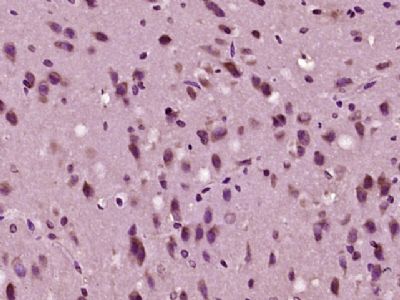产品货号 : mlR23478
英文名称 : ADAMTS10
中文名称 : 整合素样金属蛋白酶与凝血酶10型抗体
别 名 : A disintegrin and metalloproteinase with thrombospondin motifs 10; A disintegrin like and metalloprotease (reprolysin type) with thrombospondin type 1 motif, 10; ADAM metallopeptidase with thrombospondin type 1 motif 10; ADAM TS10; EC 3.4.24; WMS; ATS10_HUMAN.
研究领域 : 细胞生物 信号转导 细胞外基质
抗体来源 : Rabbit
克隆类型 : Polyclonal
交叉反应 : Human, Mouse, Rat, Pig, Cow, Horse, Rabbit, Sheep,
产品应用 : WB=1:500-2000 IHC-P=1:400-800 IHC-F=1:400-800 ICC=1:100-500 IF=1:100-500 (石蜡切片需做抗原修复)
not yet tested in other applications.
optimal dilutions/concentrations should be determined by the end user.
分 子 量 : 95kDa
细胞定位 : 细胞外基质 分泌型蛋白
性 状 : Lyophilized or Liquid
浓 度 : 1mg/ml
免 疫 原 : KLH conjugated synthetic peptide derived from human ADAMTS10 :431-530/1103
亚 型 : IgG
纯化方法 : affinity purified by Protein A
储 存 液 : 0.01M TBS(pH7.4) with 1% BSA, 0.03% Proclin300 and 50% Glycerol.
保存条件 : Store at -20 °C for one year. Avoid repeated freeze/thaw cycles. The lyophilized antibody is stable at room temperature for at least one month and for greater than a year when kept at -20°C. When reconstituted in sterile pH 7.4 0.01M PBS or diluent of antibody the antibody is stable for at least two weeks at 2-4 °C.
PubMed : PubMed
产品介绍 : ADAMTS10 is a member of the ADAMs family of proteinases with Thrombospondin motifs. The catalytic site of ADAMTS10 is typical of the metalloproteinase catalytic domains, with an HExxHxxxxxH sequence, perhaps giving these enzymes some shared specificity. ADAMTS10 is closest in homology to ADAMTS6, sharing 53% overall identity. Functional mutations in ADAMTS10 have been linked to Weill Marchesani syndrome, a connective tissue disorder marked by fibrillin 1 misprocessing. ADAMTS10 has also been reported to be over expressed in breast cancer tissues and cell lines.
Function:
Metalloprotease that participate in microfibrils assembly. Microfibrils are extracellular matrix components occurring independently or along with elastin in the formation of elastic tissues.
Subunit:
Interacts with FBN1; this interaction promotes microfibrils assembly.
Subcellular Location:
Secreted, extracellular space, extracellular matrix.
Tissue Specificity:
Widely expressed in adult tissues.
Post-translational modifications:
Glycosylated. Can be O-fucosylated by POFUT2 on a serine or a threonine residue found within the consensus sequence C1-X(2)-(S/T)-C2-G of the TSP type-1 repeat domains where C1 and C2 are the first and second cysteine residue of the repeat, respectively. Fucosylated repeats can then be further glycosylated by the addition of a beta-1,3-glucose residue by the glucosyltransferase, B3GALTL. Fucosylation mediates the efficient secretion of ADAMTS family members. Also can be C-glycosylated with one or two mannose molecules on tryptophan residues within the consensus sequence W-X-X-W of the TPRs, and N-glycosylated. These other glycosylations can also facilitate secretion (By similarity).
DISEASE:
Defects in ADAMTS10 are the cause of Weill-Marchesani syndrome 1 (WMS1) [MIM:277600]. WMS1 is a rare connective tissue disorder characterized by short stature, brachydactyly, joint stiffness, and eye abnormalities including microspherophakia, ectopia lentis, severe myopia and glaucoma.
Similarity:
Contains 1 disintegrin domain.
Contains 1 peptidase M12B domain.
Contains 1 PLAC domain.
Contains 5 TSP type-1 domains.
SWISS:
Q9H324
Gene ID:
81794
Important Note:
This product as supplied is intended for research use only, not for use in human, therapeutic or diagnostic applications.
产品图片












